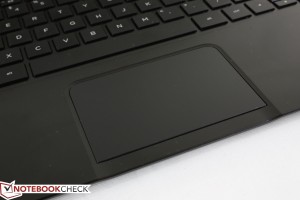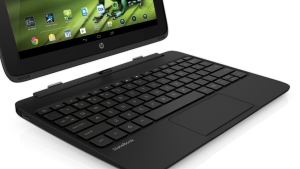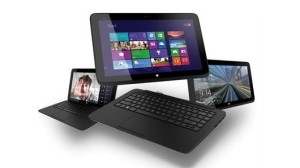The latest version, called the Split x2, is a bold reworking, moving more firmly into the laptop category, with a thin, 13-inch body and hardware closer to what you’d find in a full-time laptop. The matte-black body also brings to mind the classic black polycarbonate MacBook, although the x2 is thinner and lighter, with edge-to-edge glass over a touch screen.
The CPU is in the tablet-like top half of the system, along with the RAM, battery, and SSD storage (presumably 128GB). However, the keyboard base unit is capable of not only having a second battery (common enough in hybrids), but also a larger platter hard drive. That way, you could use the SSD in the lid for programs and frequently used files, but keep, for example, a 500GB HDD in the base for your archives of movies and music.
Case
At a combined weight and thickness of 2.3 kg (1.0 kg tablet + 1.3 kg base) and 22.9 mm (11.3 mm tablet + 11.6 mm base), respectively, the Split x2 is on the heavy side when compared to standard 13.3-inch netbooks or convertibles. The Yoga 13, Vaio Duo 13, LifeBook T902, Transformer Book TX300 and Taichi 31 – all of which are 13.3-inches in screen size – are either much thinner or lighter or even both. The weight difference can be partly attributed to the secondary battery of the Split x2 for potentially longer battery lives than the competition, but there is no denying that the HP convertible is certainly weighty for the size.
Connectivity
Speaking of the base, the unit provides 2 USB ports, an HDMI port and an SD reader. The options are almost identical to the Envy x2 and a bare minimum with regards to ultraportables; An Ethernet port, additional USB port or VGA port would have been great additions. Nonetheless, it does feel a bit odd to have a tablet with no local USB ports available.
Touchpad
The Synaptics matte touchpad is capable of recognizing up to 4-finger inputs for Windows 8 Edge Swipes, rotation, scrolling and flicking. It may not be very large (9.5 cm x 6 cm), but its size suitably fits the chassis and is responsive to basic point and clicks as well as multi-touch commands with minimal misreads.
Display
A standard 13.3-inch 1366 x 768 resolution glossy display comes standard on the Split x2 with no other available options. HP claims a contrast ratio of 200:1 and up to 262,144 colors from theglass screen, the former of which is close to our measured contrast of 256:1 on the very center of the screen.
Nonetheless, the screen itself is average at best in terms of display quality. Because of the large size, low pixel density (118 PPI) and the tendency to have tablets closer to the eyes during use, individual pixels are easy to discern. The low contrast becomes very obvious when viewing videos with dimly lit scenes as black spots appear muddy and gray.
Performance
The model in review uses a Core i3-3229Y Ivy Bridge CPU with integrated HD 4000 graphics. The 1.4 GHz ULV processor is rated for 13 Watts TDP and includes no Turbo Boost. In contrast, the GPU benefits from Turbo Boost up to 850 MHz, though this is short-lived as detailed in our stress test section below. When idle and in Power Saver mode, the CPU and GPU in the Split x2 will operate at 800 MHz and 350/800 MHz (core/memory), respectively.
Processor
CPU performance is most similar to the previous generation Sandy Bridge ULV Core i3-2377M. As examples, the single-threaded Super Pi 32M benchmark completes in 1401 seconds vs. 1338 seconds in the i3-2377M and the multi-threaded wPrime 1024M benchmark completes in 1220 seconds vs. 1141 seconds in the Sandy Bridge equivalent. CineBench scores are also slightly better for the older model compared to the i3-3229Y.
Related articles
- HP SlateBook x2 convertible tablet now available for $479 (liliputing.com)
- The Intel 22nm Microarchitecture “Ivy Bridge-E” Review. (djchams.wordpress.com)
- Top 10 Ultrabooks for Business (technoinsta.com)
- HP Split x2 is a Detachable Windows 8 Notebook PC (shoppingblog.com)
- Intel Core i7 4960X EE CPU / Asus X79-Deluxe Motherboard Review (kitguru.net)
- Intel Ivy Bridge-E Core i7 High-End Desktop Processors Now Available For Sale (wccftech.com)


